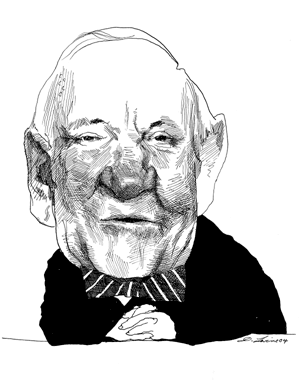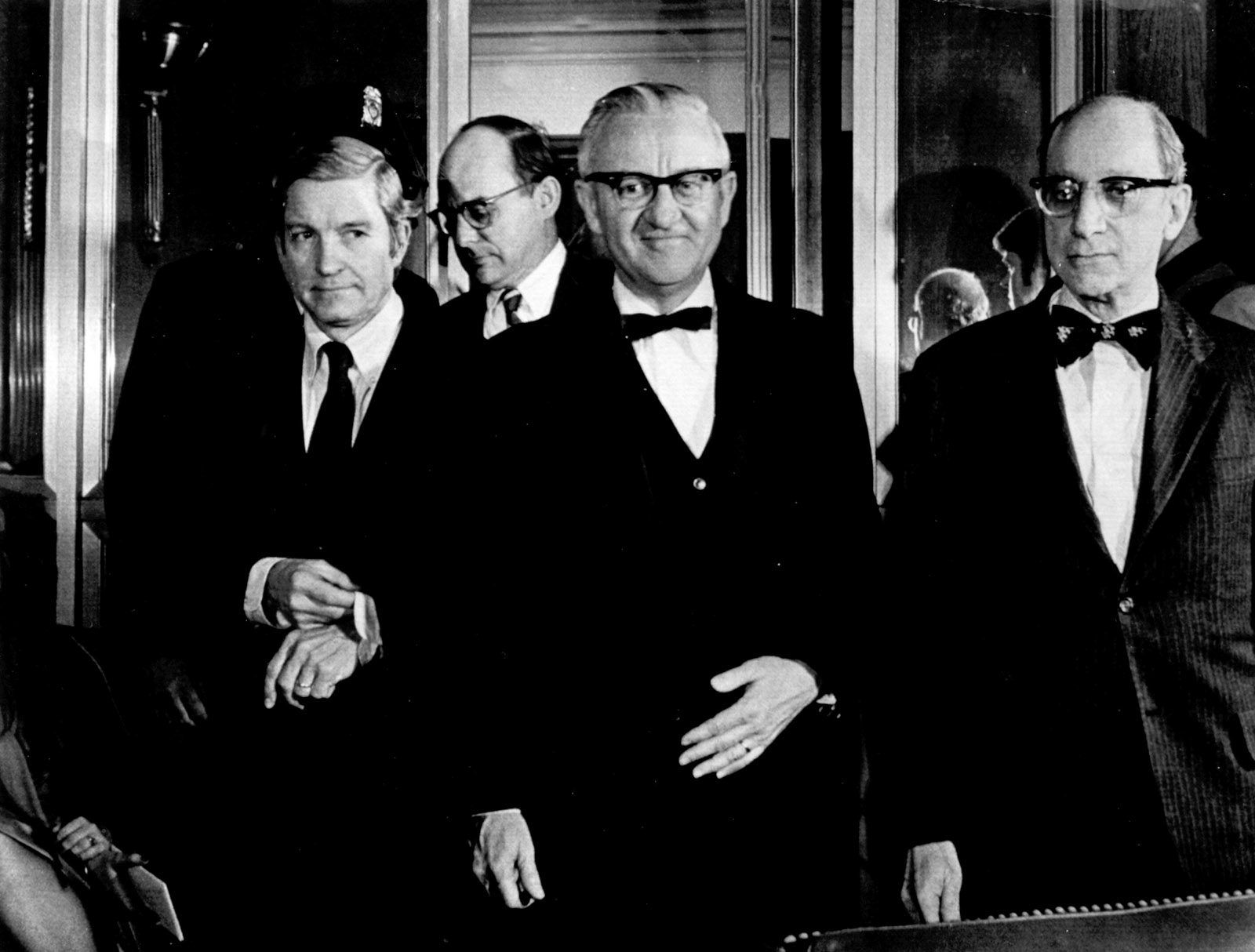The inspiring legacy of Justice John Paul Stevens—including both the brilliance of his mind and the humaneness of his character—are well represented in his last book, The Making of a Justice, published just two months before his death this past July at age ninety-nine. But if, as seems likely, the US Supreme Court is poised to embark on a voyage of regression, the book makes for wistful reading as well. For Stevens was a throwback to the postwar liberal Republican appointees (for example, Chief Justice Earl Warren and Justice William Brennan) who did so much to transform the Supreme Court, for a time, into an engine of social progress.
The Court has more often been a barrier to change. In the pre–Civil War period, much of its attention was dedicated to upholding slavery (in cases such as Dred Scott). After the Civil War, it devoted its efforts to undercutting Reconstruction (as in the so-called Civil Rights Cases), justifying segregation (as in Plessy v. Ferguson), and opposing the actions of labor unions (as in Loewe v. Lawlor). In the first half of the twentieth century, it tried to nullify many parts of the New Deal, upheld the wartime detention of Japanese-Americans, and did much to restrict free speech (as in Schenck v. United States, in 1919, which criminalized criticism of the draft during wartime). And from the last decades of the twentieth century to the present, the Court has focused a good deal of its energy on narrowing the Fourth and Fifth Amendment protections against police misconduct that the Warren Court had expanded, and on buttressing the power of big business and the interests of the wealthy in ways most obviously exemplified by Citizens United.
Whatever the reasons for the Court’s traditionally conservative slant—whether clothed in language of “judicial restraint” (as in its recent refusal to remedy blatant political gerrymandering), “textualism,” “originalism,” or just barely disguised political advantage (as in Bush v. Gore)—too much of the Court’s history bespeaks regressive tendencies, of which, in hindsight, one can only be ashamed. But for a short period in the mid-twentieth century, the Court was able to escape those shackles and concentrate instead on furthering the broad principles and promises embodied in the Constitution and the Declaration of Independence as applied to modern conditions. Stevens very much shared that view of the Court’s purpose, but over the course of his tenure the ideological balance of the Court changed, which made it harder for him to carry out this vision.
An especially interesting part of Stevens’s book is the first 130 pages or so, which recount his upbringing and training before he joined the Court. He grew up in a wealthy Chicago family that prized the kind of self-restraint that now seems so out of style. Although one would hardly know it from his modest account, he was both a superlative student (achieving the highest grades in the history of Northwestern Law School) and a talented athlete (playing as an undergraduate on the University of Chicago’s undefeated tennis team of 1938)—not to mention a great fan of the Chicago Cubs. Later in the book, he describes his throwing the ceremonial first pitch at one of the Cubs’ games at Wrigley Field in 2005 as “unquestionably the high point of my career.” (I asked one of Stevens’s former law clerks whether he meant this literally, and she responded, “Absolutely!”)
A primary business of Stevens’s immediate family was running the upscale Stevens Hotel in Chicago. But when it faced insolvency during the Great Depression, the hotel “borrowed” more than $1 million from the Illinois Life Insurance Company, which was controlled by Stevens’s grandfather, uncle, and father. Illinois state prosecutors saw this transfer as a form of embezzlement and indicted the three family members. Upon hearing the news, Stevens’s grandfather suffered a stroke and his uncle committed suicide, leaving Stevens’s father to face trial alone. A Chicago jury convicted him, but the Illinois Supreme Court subsequently reversed the conviction and directed an acquittal, finding no evidence of criminal intent.
Although one suspects that these events were traumatic for Stevens, who was still in his early teens, he recounts them in a typically matter-of-fact way. But what he says he learned from the experience is revealing: “In recent years, my firsthand knowledge of the criminal justice system’s fallibility has reinforced my conviction that the death penalty should be abolished.”
Most of Stevens’s book, however, is devoted to a chronological description of each of the thirty-five terms that he served on the US Supreme Court, from 1975 to 2010 (making him the third-longest-serving justice in the history of the Court). For each term, Stevens selected a few cases that he considered particularly noteworthy, explaining in detail how they came to be decided and what he thought of them. A few general insights can be gleaned from his descriptions.
Advertisement
First, Stevens was from the outset—and more than was recognized—one of the most liberal members of the Court (though he would undoubtedly resist that label). Second, he always maintained a cordial relationship with each of his colleagues, even those he sometimes thought were deeply mistaken. He did this both because he was by nature collegial and so that he could be more persuasive in close cases. Third, Stevens approached each case by asking how it fit within what he regarded as the first principles of law and the Constitution, and only after answering this question did he turn his attention to the more technical issues the case presented. As a result, his view of a case was often different from that of his colleagues, even when he was in the majority.
Each of these points may be illustrated by reference to certain fundamental issues that preoccupied Stevens throughout his time on the Court and that he constantly revisits in his book. They are largely the same issues that led him in 2014 to write a book recommending six amendments to the Constitution.1 (And, oh yes, he also wrote for The New York Review.) But a fascinating aspect of his memoir is his descriptions of how he sought, but often failed, to persuade his colleagues that his view of these issues was consistent with the Constitution, if not, indeed, mandated by it.
One such issue is the doctrine of sovereign immunity, which holds that you cannot sue any state or federal government agency, or any of its officers or employees, for any wrong they may have committed against you, unless the state or federal government consents to being sued. English common law justified this extraordinary immunity by declaring that “the king can do no wrong.” But aside from the absurdity of this proposition if taken literally, Stevens points out that our country was founded on the belief that the king had indeed committed egregious wrongs that could not be tolerated. And nowhere does the Constitution use the term “sovereign immunity.”
So why does this doctrine continue to play a prominent part in US law, leading to the dismissal of numerous cases brought against government agencies and employees by people injured by official misconduct? The answer from a legalistic viewpoint is that since the American Revolution, both federal and state courts have continued to look to English common law in determining the precedents that would guide them. The answer from a more practical viewpoint is that government agencies and their employees would arguably be handicapped in the performance of their duties if they faced the prospect of constantly being sued. And the answer from a constitutional viewpoint, according to some Supreme Court cases, is that the Eleventh Amendment—which on its face simply forbids the federal courts from hearing cases brought against a state by citizens of another state—is somehow premised upon and thereby incorporates the doctrine of sovereign immunity, at least as far as the states are concerned.
Stevens will have none of this. Why, he asks, should governments or their agents be above the law? The Eleventh Amendment, he asserts, “was never intended to constitutionalize the doctrine of state sovereign immunity” but simply to overrule Chisholm v. Georgia (1793) by creating a limited exception to federal jurisdiction.
In his earlier years as a justice, when the Court, though becoming more conservative, was still more liberal than it is today, Stevens seemed on the verge of convincing his colleagues of his view. In Nevada v. Hall (1979), in which the question was “whether there is any basis in the Constitution or any federal statute for imposing a requirement that state courts must grant immunity to all of their sister states,” Stevens wrote the majority opinion for the Court rejecting such a claim. In his book, he further notes that even the dissent by then Justice William Rehnquist did not “attempt to explain why the ancient doctrine of sovereign immunity should be kept alive in a democratic country.”
Nevertheless, Stevens made no more progress on this issue. He writes that in Seminole Tribe of Florida v. Florida (1996), “the Court changed course and incorrectly endorsed the view that the Eleventh Amendment reflects a broader constitutional principle of sovereign immunity that protects states from virtually all suits in federal court.” And three years later, in Alden v. Maine, “the Court announced one of the most profound changes in the law in the Court’s history, holding that the doctrine of sovereign immunity barred an action brought against the state of Maine by a group of its probation officers to recover certain compensation mandated by the overtime provisions of [federal law].”
In his book, Stevens denounces Alden as “one of the least wise decisions in our history,” but it proved to be a sign of the future. On May 13 of this year, the Court, in Franchise Tax Board of California v. Hyatt (involving the question of whether a state could be sued in the courts of another state), overruled Nevada v. Hall, causing Justice Stephen Breyer to write in dissent that “today’s decision can only cause one to wonder which cases the Court will overrule next.” But while we might well share Justice Breyer’s concern, the question is perhaps not so much one of precedent—too rigid adherence to which can often itself be stultifying—but rather, as Stevens argues, one of whether the doctrine of sovereign immunity has any real support anywhere in the Constitution.
What is going on here? Although the doctrine of sovereign immunity applies to both state and federal governments, in practice the cases before the Supreme Court in which the doctrine has figured most prominently have involved federal deference to states’ sovereign immunity. In other words, the issue is bound up with the debate over federalism and “states’ rights” that has preoccupied our country from the beginning. Since the Civil War, the greatest proponents of states’ rights have been found in the South, whose votes have become crucial to the Republican Party, which has in turn demanded that Republican appointees to the Supreme Court be “right-minded” on this issue. While, ironically, the actions of the Trump administration have fostered a renewed liberal interest in states’ rights, in the Supreme Court the debate over sovereign immunity may in part be just one more unfortunate vestige of the divisions created by the Civil War.
A second issue that permeates much of Stevens’s book is the increasing resistance of the Supreme Court to most meaningful forms of gun control. This, in turn, involves interpretation of the Second Amendment, which reads, “A well regulated Militia, being necessary to the security of a free State, the right of the people to keep and bear Arms, shall not be infringed.” As Stevens notes, for two hundred years the Court took it as more or less given that this language referred to the right of states to maintain their own militias (the familiar National Guard units). In 1939 a unanimous Supreme Court held in United States v. Miller that the Second Amendment’s protection of the right to bear arms was possessed only by members of these militias. But in 2008, in District of Columbia v. Heller, a bare majority of the Supreme Court, in an opinion by Justice Antonin Scalia, effectively ignored the first thirteen words of the amendment (i.e., half of it) and held that it prohibited most restrictions on civilian possession and use of firearms.
Stevens is uncharacteristically angry in denouncing this exercise in imagination, writing that “Heller is unquestionably the most clearly incorrect decision that the Court announced during my tenure on the bench.” For good measure, he adds that it represents “the worst self-inflicted wound in the Court’s history” because it will lead to so many otherwise preventable killings. But what I found fascinating is Stevens’s account of how he thought he could convince Anthony Kennedy or even Clarence Thomas to vote the other way. He writes:
I had frequent conversations with Tony, as well as occasional discussions with Clarence Thomas about historical issues [relating to the Second Amendment]…. In those discussions—particularly those with Tony—I now realize that I failed to emphasize sufficiently the human aspects of the issue.
But what Stevens perhaps did not fully appreciate was how far to the right the Court had already moved.
While Stevens’s book covers many other controversial issues, a final example worthy of note is his opposition to the death penalty. Repeatedly he asserts that while he once accepted arguments for the constitutionality of the death penalty, he came to believe that they are unconvincing because of incontrovertible evidence that innocent people have been sentenced to death. Referring to the 1976 decision of the Court to reinstate the death penalty that it had declared unconstitutional in 1972,2 Stevens writes:
Whether or not my vote to uphold the validity of capital punishment in 1976 was correct, I am now persuaded that the very real risk that an innocent person may be put to death in such a case provides a sufficient reason for ending that form of punishment.
And he adds:
When the Court reviewed the constitutionality of the death penalty at length in 1976, none of us seriously considered the magnitude of the risk of error in capital cases. It is now perfectly clear that it is a risk that no civilized society should tolerate.
This and numerous similar statements made by Stevens throughout his book endorsed the theory on which, in 2002, I held the federal death penalty unconstitutional, only to have my decision reversed some months later by an intermediate court of appeals.3 That theory has never been squarely presented to the Supreme Court, but I fear that the current Court (endorsing a position strongly supported by the current administration) would still approve “a risk that no civilized society should tolerate.”
Stevens, however, ended this, his last book, without expressing the bitterness that one might expect of a great judge who saw so many of his views rejected by a majority of his colleagues. The reason, it seems, is that he still believed that the fundamental principles on which our nation rests would ultimately prevail in the Supreme Court. The history of the Court, not least in recent years, provides less confidence for that prediction.
This Issue
September 26, 2019
Australia’s Shame
Brexit: Fools Rush Out
‘Ulysses’ on Trial
-
1
John Paul Stevens, Six Amendments: How and Why We Should Change the Constitution (Little, Brown, 2014). ↩
-
2
Furman v. Georgia (1972; declaring the death penalty unconstitutional); Gregg v. Georgia (1976; reinstating the death penalty). ↩
-
3
United States v. Quinones (S.D.N.Y. 2002), reversed in United States v. Quinones (2d Cir. 2002). ↩





